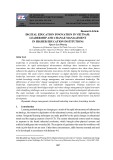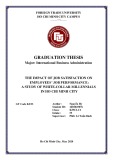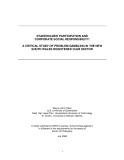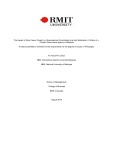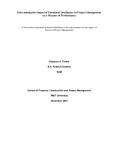
TNU Journal of Science and Technology
230(03): 131 - 138
http://jst.tnu.edu.vn 131 Email: jst@tnu.edu.vn
ANALYSIS OF THE RELATIONSHIP BETWEEN
CORPORATE SOCIAL RESPONSIBILITY AND EMPLOYEE ATTITUDES
IN HIGHER EDUCATION INSTITUTIONS
Duong Thi Hoai Nhung*, Hoang Phuc Duc
Foreign Trade University
ARTICLE INFO
ABSTRACT
Received:
08/11/2024
The aim of this study is to clarify the effects of corporate social responsibility
on employee attitudes in higher education institutions. In particular, the study
will use the theory of social identity to investigate how corporate social
responsibility affects workers' job satisfaction, organizational identification,
and work engagement. Data from teaching and non-teaching staff at public
higher education institutions in the North of Vietnam were gathered by using
self-reported questionnaires. The collected data from 171 responses were
analyzed using structural equation modeling approach. This approach made it
possible to investigate the proposed correlations between the variables,
offering a thorough comprehension of how corporate social responsibility
affects employee attitudes. The study's findings show that, in the context of
higher education institutions, corporate social responsibility is strongly
correlated with work engagement, job satisfaction, and organizational
identification. This study examines theoretical contributions in order to give
practitioners and scholars interested in this field fresh new insights and
knowledge. The results will give higher education institutions useful advices
on how to encourage favorable employee attitudes, which will ultimately
help the organizations succeed.
Revised:
31/3/2025
Published:
31/3/2025
KEYWORDS
Corporate social responsibility
Work engagement
Job satisfaction
Identification with the
organization
Higher education institutions
PHÂN TÍCH MỐI QUAN HỆ GIỮA TRÁCH NHIỆM XÃ HỘI CỦA TỔ CHỨC
VỚI THÁI ĐỘ CỦA NHÂN VIÊN TẠI CÁC CƠ SỞ GIÁO DỤC ĐẠI HỌC
Dương Thị Hoài Nhung*, Hoàng Phúc Đức
Trường Đại học Ngoại thương
THÔNG TIN BÀI BÁO
TÓM TẮT
Ngày nhận bài:
08/11/2024
Mục đích của nghiên cứu này nhằm làm rõ tác động của trách nhiệm xã
hội của tổ chức đến thái độ của nhân viên tại các cơ sở giáo dục đại học.
Cụ thể, nghiên cứu sẽ sử dụng lý thuyết về bản sắc xã hội để điều tra cách
trách nhiệm xã hội của tổ chức ảnh hưởng đến sự hài lòng trong công việc,
nhận dạng tổ chức và sự gắn kết công việc của người lao động. Dữ liệu từ
đội ngũ giảng viên và cán bộ hỗ trợ tại các cơ sở giáo dục đại học công lập
ở miền Bắc Việt Nam được thu thập bằng cách sử dụng bảng câu hỏi tự
báo cáo. Dữ liệu thu thập với 171 câu trả lời đã được phân tích bằng
phương pháp mô hình phương trình cấu trúc. Phương pháp này giúp điều
tra các mối tương quan được đề xuất giữa các biến, cung cấp sự hiểu biết
sâu sắc về cách CSR ảnh hưởng đến thái độ của nhân viên. Các phát hiện
của nghiên cứu cho thấy, trong bối cảnh của các các cơ sở giáo dục đại
học, trách nhiệm xã hội của tổ chức có mối tương quan chặt chẽ với sự
gắn kết công việc, sự hài lòng trong công việc và sự nhận dạng về tổ chức
của nhân viên. Nghiên cứu này xem xét các đóng góp về mặt lý thuyết để
cung cấp cho những người hoạt động thực tiễn và học giả quan tâm đến
lĩnh vực này những hiểu biết và kiến thức mới mẻ. Kết quả sẽ cung cấp
cho các các cơ sở giáo dục đại học những lời khuyên hữu ích về cách
khuyến khích thái độ tích cực của nhân viên, điều này sẽ giúp các tổ chức
đạt được thành công.
Ngày hoàn thiện:
31/3/2025
Ngày đăng:
31/3/2025
TỪ KHÓA
Trách nhiệm xã hội của tổ chức
Sự gắn kết công việc
Sự hài lòng trong công việc
Sự nhận dạng tổ chức của nhân
viên
Cơ sở giáo dục đại học
DOI: https://doi.org/10.34238/tnu-jst.11514
* Corresponding author. Email: nhungdth@ftu.edu.vn

















